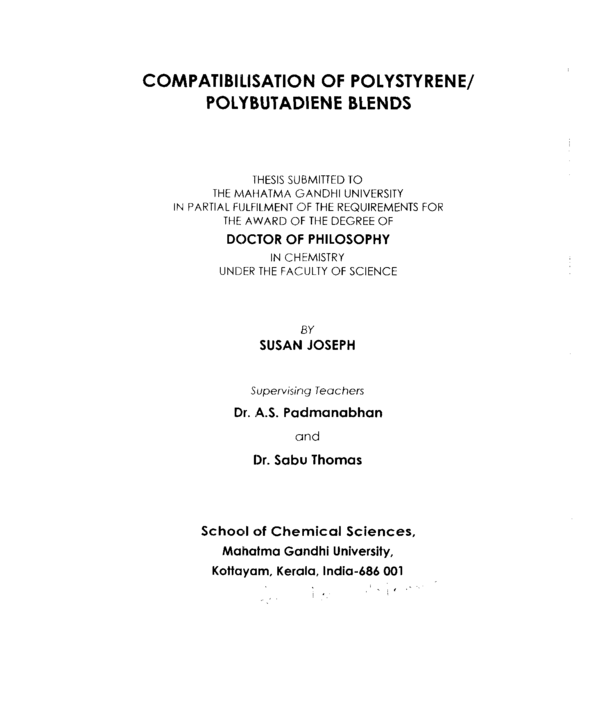| |||||||||||
- TITLE
- CERTIFICATE-1
- CERTIFICATE-2
- DECLARATION
- ACKNOWLEDGEMENT
- Preface
- List of Abbreviations
- CONTENTS
- 1. INTRODUCTION
- 1.1 Polymer blends
- 1.2 Classification and preparation of polymer blends
- 1.2.1 Thermoplastic elastomers (TPEs)
- 1.2.2 Classification of thermoplastic elastomers
- 1 3 Thermodynamics of Miscibility
- 1.3.1 One phase polymer blends
- 1.4 Compatibility Predictions
- 1.4.1 Solubility parameter approach
- 1.5 Compatibilisation Strategy
- 1. 5.1 Physical compatibilisation
- (a) Compatibilisation by block copolymers
- (b) Compatibilisation by graft copolymer
- (c) Compatibilisation by random copolymers
- 1.5.2 Reactive compatibilisation
- 1.6 Mechanism for phase morphology refinement
- 1.7 Effect of compatibilisation or interfacial thickness
- 1.8 Interfacial stability of the copolymer
- 1.9 Factors Affecting the Efficiency of Compatibiliser
- 1.9.1 Chemical nature of the compatibiliser
- 1.9.2 Copolymer chain microstructure
- 1 9.3 Molecular mass and composition of the Copolymer
- 1 9.4 Concentration of the copolymer
- 1.9.5 Mode of incorporation of the compatibiliser
- 1.10 Organisation of the Copolymer at the Blend Interface
- 1.11 Physical Versus Reactive Blending
- 1.12 Theories of compatibilisation
- 1.13 Other routes of compatibilisation
- 1.13. 1 Solution casting method
- 1. 13.2 Dynamic cross linking
- 1.14 Phase morphology development in physical blending
- 1.15 Effect of physical blending on phase morphology
- 1.16 Blends based on PS and PB
- 1.17 Scope and objective of the work
- 1.18 References
- 2. EXPERIMENTAL TECHNIQUES
- 2.1 Materials
- 2.1.1 Polystyrene (PS)
- 2.1.2 Polybutadiene (PB)
- 2.1.3 Styrene butadiene rubber (SBR)
- 2.1.4 Poly (styrene-b-butadiene-b-styrene) rubber (SBS)
- 2.2 Preparation of the blends
- 2.3 Measurements
- 2.3.1 Phase morphology analysis
- 2.3.2 Analysis of morphological parameters
- 2.3.3 Co-continuity calculation / solvent dissolution
- 2.3.4 Static mechanical properties
- 2.3.5 Rheological measurements
- 2.3.5 (1) Extrudate morphology analysis
- (2) Melt elasticity
- 2.3.6 Thermal properties
- (1) Thermogravimetric analysis (TGA)
- (2) Differential scanning calorimetric measurements (DSC)
- 2.3.7 Dynamic mechanical analysis (DMA)
- 2.3.8 Solid-state nuclear magnetic resonance spectroscopy (NMR) studies
- 2.4 References
- 3. PHASE MORPHOLOGY
- 3.1 Introduction
- 3.2 Results and discussion
- 3.2.1 Influence of mixing time
- 3.2.2 Influence of mixing temperature
- 3.2.3 Influence of rotor speed
- 3.2.4 Effect of blend ratio
- 3.2.5 Cocontinuity calculation
- 3.2.6 Effect of copolymer addition on dispersed phase size
- 3.2.7 Comparison with theory
- 3.2.8 Conformation of the copolymer at the interface
- 3.2.9 Influence of annealing
- 3.3 Conclusions
- 3.4 References
- 4. MECHANICAL PROPERTIES
- 4.1 Introduction
- 4.2 Results and discussion
- 4.2.1 Influence of rotor speed
- 4.2.2 Influence of mixing temperature
- 4.2.3 Influence of mixing time
- 4.2.4 Effect of blend ratio
- 4.2.5 Modelling of tensile moduli
- 4.2.6 Tensile moduli of co-continuous regions
- 4.2.7 Effect of compatibilisation on mechanical properties
- 4.2.8 Effect of dynamic vulcanization
- 4.3 Conclusions
- 4.4. References
- 5. RHEOLOGICAL. PROPERTIES
- 5.1 Introduction
- 5.2 Results and discussion
- 5.2.1 Melt viscosity
- 5.2.2 Comparison with theoretical predictions
- 5.2.3 Effects of compatibilisation
- 5.2.4 Flow behavior index and consistency index values
- 5.2.5 Melt elasticity
- 5 2.5.1 Extrudate swell
- 5.2.5.2 Principal normal stress difference (T11-T22)
- 5.2.5.3 Recoverable shear strain (SR)
- 5.2.6 Extrudate morphology
- 5.2.6.1 Effect of blend ratio and shear rate
- 5.2.6.2 Effect of compatibilisation
- 5.3. Conclusions
- 5.4. References
- 6. THERMAL PROPERTIES
- 6.1 Introduction
- 6.2 Results and discussion
- 6.2.1 Effect of blend ratio
- 6.2.2 Effect of compatibilisation
- 6.2.3 Kinetics of degradation
- 6.2.4 Differential scanning calorimetry
- 6.3 Conclusion
- 6.4 References
- 7. DYNAMIC MECHANICAL PROPERTIES
- 7.1 Introduction
- 7.2 Results and discussion
- 7.2.1 Uncompatibilised Blends
- 7.2.2 Modulus-composition models
- 7.2.3 Effect of compatibilisation
- 7.2.4 Cole-Cole plot
- 7.2.5 Degree of entanglement density
- 7.3 Conclusion
- 7.4 References
- 8. NUCLEAR MAGNETIC RESONANCE SPECTROSCOPY
- 8.1 Introduction
- 8.2 Results and discussion
- 8.2.1 NMR spectroscopy of homopolymers
- 8.2.2 PS / PB incompatible blends
- 8.2.3 Effect of compatibilisation
- 8.3 Conclusions
- 8.4 References
- 9. GENERAL CONCLUSIONS
- 9.1 Conclusions
- 9.2 Future scope of the work
- 9.2.1 Location of the Copolymer at the Interface
- 9.2.2 Calculation of Interfacial Thickness
- 9.2.3 Dynamically Vulcanised Blends
- 9.2.4 Transport Studies
- 9.2.5 Effect of Various Fillers
- 9.2.6 Gas Permeation Studies
- 9.2.7 Nanoparticles
- 9.2.8 Fabrication of Useful Products
- APPENDIX
- CURRICULUM VITAE
- List of Publications




 Full Screen
Full Screen


